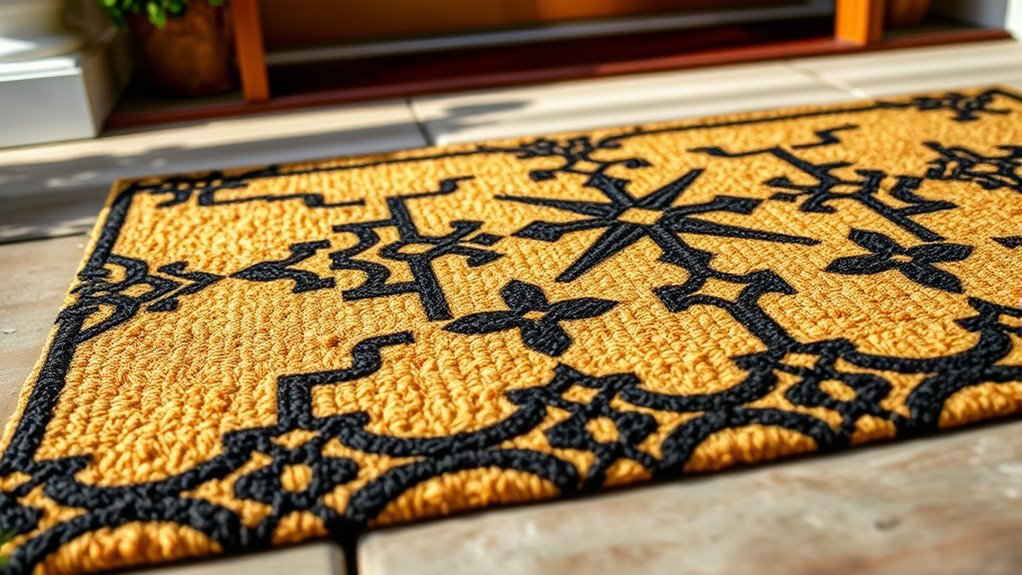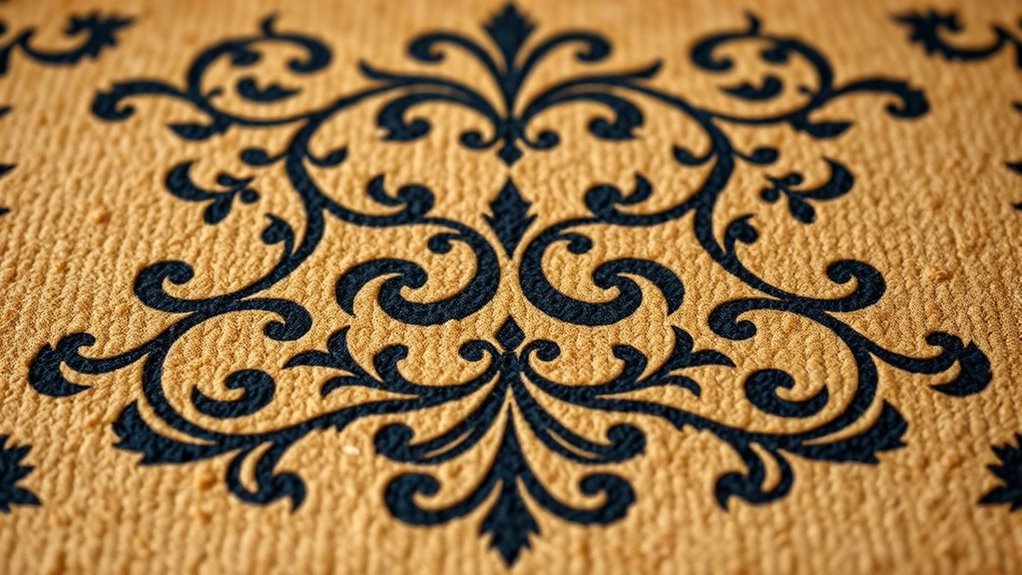Creating a stenciled doormat is simple and fun. Start by choosing a design that reflects your style, then transfer it onto your mat using a stencil or freehand drawing. Secure your stencil with painter’s tape for accuracy. Use exterior acrylic paint and a stencil brush or foam roller to apply thin, even coats. Once dry, consider sealing your design with a waterproof spray to boost weather resistance. Keep exploring to discover detailed tips for perfect results!
Key Takeaways
- Choose a suitable doormat material like rubber or vinyl and clean it thoroughly before starting.
- Select or create a design and transfer it onto the doormat using a stencil or freehand drawing.
- Secure the stencil with painter’s tape and apply exterior acrylic paint evenly with a stencil brush or foam roller.
- Allow the paint to dry for at least 24 hours, then consider sealing with a waterproof spray for added durability.
- Regularly clean and maintain the doormat to preserve the design and extend its lifespan.

Creating a custom stenciled doormat is a fun and straightforward way to add personality to your entryway. You don’t need to be an artist or have professional skills—just a bit of patience and the right supplies. When it comes to DIY techniques, the key is preparation and precision. Start by choosing a design that reflects your style, whether it’s a welcoming phrase, a pattern, or a fun graphic. Once your design is ready, transfer it onto your doormat using a stencil or by freehand drawing if you’re comfortable. Using painter’s tape to secure your stencil in place ensures it doesn’t shift during painting, which is *essential* for clean lines.
Personalize your entryway with a DIY stenciled doormat—simple, fun, and full of charm.
Material choices are *crucial* for achieving a durable, attractive finish. The most common doormat materials are coir, rubber, and vinyl. Coir mats are traditional and absorbent, making them perfect for outdoor use, but they can be a bit rough for detailed painting. Rubber mats offer a smoother surface, providing a cleaner canvas for your design and lasting longer in high-traffic areas. Vinyl mats are lightweight, flexible, and easy to work with, making them ideal for detailed or intricate designs. Whichever material you select, *make sure* it’s clean and dry before starting your project. Dirt or moisture can cause paint to bleed or not adhere properly, ruining your design.
Next, choose your paint wisely. Exterior acrylic paint works well because it’s weather-resistant and durable, perfect for outdoor use. For indoor doormats, craft paints or fabric paints can also work, but *make certain* they’re suitable for your material. Before painting your design, do a test on a small, inconspicuous area to see how the paint interacts with the surface. Use a stencil brush or a mini foam roller for even coverage, applying thin coats to prevent bleeding under the stencil. Work slowly and carefully, especially around the edges of your design, to keep lines crisp.
Once your painting is complete, let the paint dry thoroughly—usually at least 24 hours—before placing the doormat outside or in high-traffic areas. To increase longevity, consider sealing your design with a clear outdoor sealant or waterproof spray. This extra step helps protect your artwork from the elements and wear over time. Additionally, choosing appropriate paint and materials ensures your design stays vibrant and intact longer. With the right DIY techniques and material choices, you can create a personalized, eye-catching doormat that welcomes guests with style and charm. It’s a simple project that brings a big impact, all while showcasing your creativity and sense of humor.
Frequently Asked Questions
What Materials Are Best for Outdoor Doormats?
You should choose weather-resistant materials like rubber, coir, or polypropylene for outdoor doormats, as they withstand rain, snow, and sun. These options are durable and easy to clean. Also, consider eco-friendly options such as recycled rubber or biodegradable coir to reduce environmental impact. These materials guarantee your doormat stays in good shape while being sustainable, making them perfect choices for outdoor use.
How Long Does Stencil Paint Last Outdoors?
Your stencil paint can last outdoors for about 1 to 3 years, depending on weather resistance and paint durability. Think of it as a shield against the elements—when you choose high-quality, weather-resistant paint, it’s like giving your doormat a sturdy armor that withstands rain, sun, and snow. Regular sealing can extend its life, so your welcoming message stays bright and vibrant, greeting visitors for years to come.
Can I Reuse the Stencil for Multiple Projects?
Yes, you can reuse your stencil for multiple projects, but its durability depends on the material and how carefully you handle it. To guarantee project reuse, clean the stencil thoroughly after each use and store it flat or in a protective roll. With proper maintenance, your stencil’s durability increases, allowing you to enjoy multiple stencil projects without worrying about it tearing or losing detail.
What Are Common Mistakes to Avoid?
When stenciling your doormat, avoid common mistakes like choosing stencil designs that are too intricate, which can cause bleeding or uneven paint. Make sure to seal the painted doormat properly afterward to protect your design from weather damage. Additionally, guarantee the stencil is securely taped down and use consistent, light coats of paint. Taking these steps helps achieve clean lines and a durable finish that lasts longer.
How Do I Clean My Stenciled Doormat?
To clean your stenciled doormat, start with gentle cleaning techniques like sweeping to remove dirt and debris. For stain removal, mix mild soap with water and use a soft brush or cloth to scrub lightly. Avoid harsh chemicals that could damage the stencil or paint. Rinse with clean water and let it air dry. Regular maintenance helps keep your doormat looking fresh and vibrant, extending its lifespan.
Conclusion
Now that you’ve created your stenciled doormat, it’s ready to greet visitors like a friendly handshake. Your personal touch turns a simple mat into a warm welcome, making your doorstep feel inviting and unique. Just remember, with a little creativity and effort, you’ve painted a picture of hospitality that’ll make everyone feel at home. So step back, admire your work, and watch as your porch becomes the heart of your home—your own little piece of sidewalk art.









